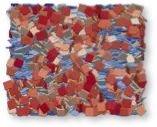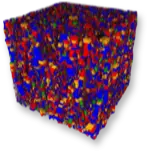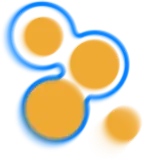Archi-texture of inertial granular flows
E Azéma & F Radjai
By means of extensive 3D numerical simulations, we analyze the microstructure of dense granular flows and its relation with shear strength as a function of the inertial number I representing the ratio of particle relaxation time to shear time. We find that the shear strength increases with I only as a consequence of increasing anisotropy of the contact network whereas the anisotropy of force chains remains nearly constant. The contact network undergoes topological transitions, and beyond I ≃ 0.25 the force chains break into clusters immersed in a background “soup” of floating particles. We show that this transition coincides with the divergence of the size of fluidized zones.
Continue Reading...Particle shape dependence in granular media
CEGEO Group
Particle shape is a key to the space-filling and strength properties of granular matter. We consider a shape parameter η describing the degree of distortion from a perfectly spherical shape. Encompassing most specific shape characteristics such as elongation, angularity and non- convexity, η is a low-order but generic parameter that we used in a numerical benchmark test for a systematic investigation of shape-dependence in sheared granular packings composed of particles of different shapes. We find that the shear strength is an increasing function of η with nearly the same trend for all shapes, the differences appearing thus to be of second order compared to η. We also observe a nontrivial behavior of packing fraction which, for all our simulated shapes, increases with η from the random close packing fraction for disks, reaches a peak considerably higher than that for disks, and subsequently declines as η is further increased. These findings suggest that a low-order description of particle shape accounts for the principal trends of packing fraction and shear strength. Hence, the effect of second-order shape parameters may be investigated by considering different shapes at the same level of η.
Continue Reading...Effect of the platy shape of the particles
M Boton, E Azéma, N Estrada, F Radjaï and A Lizcano

This is the first paper of a series devoted to the study of clayey soils from a micromechanical perspective. We specifically focus on the effect of the platy shape of particles, typical of clays, in the mechanical behavior and microstructure of dry assemblies by means of discrete element simulations. The particles are three-dimensional square plates, approximated as spheropolyhedra. Several samples composed of particles of different levels of platyness (ratio of length to thickness) were numerically prepared and sheared up to large deformations. We analyzed the shear strength, solid fraction, orientation of the particles, connectivity, fabric of the interactions network, and interaction forces as functions of the particles' platyness. We found that both the mechanical behavior and the microstructure were strongly dependent on the particles' platyness. In particular, we found that the principal phenomenon underlying these dependences is the alignment of the particles' faces along a particular direction. This ordering phenomenon, which emerges even for shapes that deviate only slightly from that of a sphere, enhances the ability of the packing to develop an anisotropic structure, developing large shear strengths, especially as a consequence of the interactions fabric and the mobilization of friction forces. Additionally, the connectivity of the packings and their solid fraction also evolve with the particles' platyness. In particular, the solid fraction evolves in a non-monotonic fashion, as is usual for granular materials made up of non spherical particles.
Continue Reading...Packings of irregular polyhedral particles: strength, structure and effects of angularity
E Azéma, F Radjaï and F Dubois

We present a systematic numerical investigation of the shear strength and structure of granular packings composed of irregular polyhedral particles. The angularity of the particles is varied by increasing the number of faces from 8 (octahedron-like shape) to 596. The shear strength increases with angularity up to a maximum value and saturates as the particles become more angular (below 46 faces). This finding extends the results of a previous study of regular polygons in two dimensions to irregular polyhedra in three dimensions. We also find that the packing fraction increases with angularity to a peak value but declines for more angular particles. We analyze the connectivity and anisotropy of the contact network and show that the increase of the shear strength with angularity is due to a net increase of fabric and force anisotropies but at higher particle angularity a rapid fall-off of the fabric anisotropy is compensated by an increase of force anisotropy, leading thus to the saturation of shear strength.
Continue Reading...